We may earn income from links in this post. Please read this Disclosure for details.
If you’re planning a beach vacation and are worried about the current seaweed conditions in Cancun and Riviera-Maya, this post has important information about seaweed season.
It also has the latest updates on the Cancun seaweed problem and details on sargassum seaweed forecast for 2025.
Satellite observations and on site reports show a sharp rise in Atlantic sargassum in May 2025. It’s turning out to be the worst year for sargassum seaweed on record.
Read on to see original photos and learn which areas could be at risk.
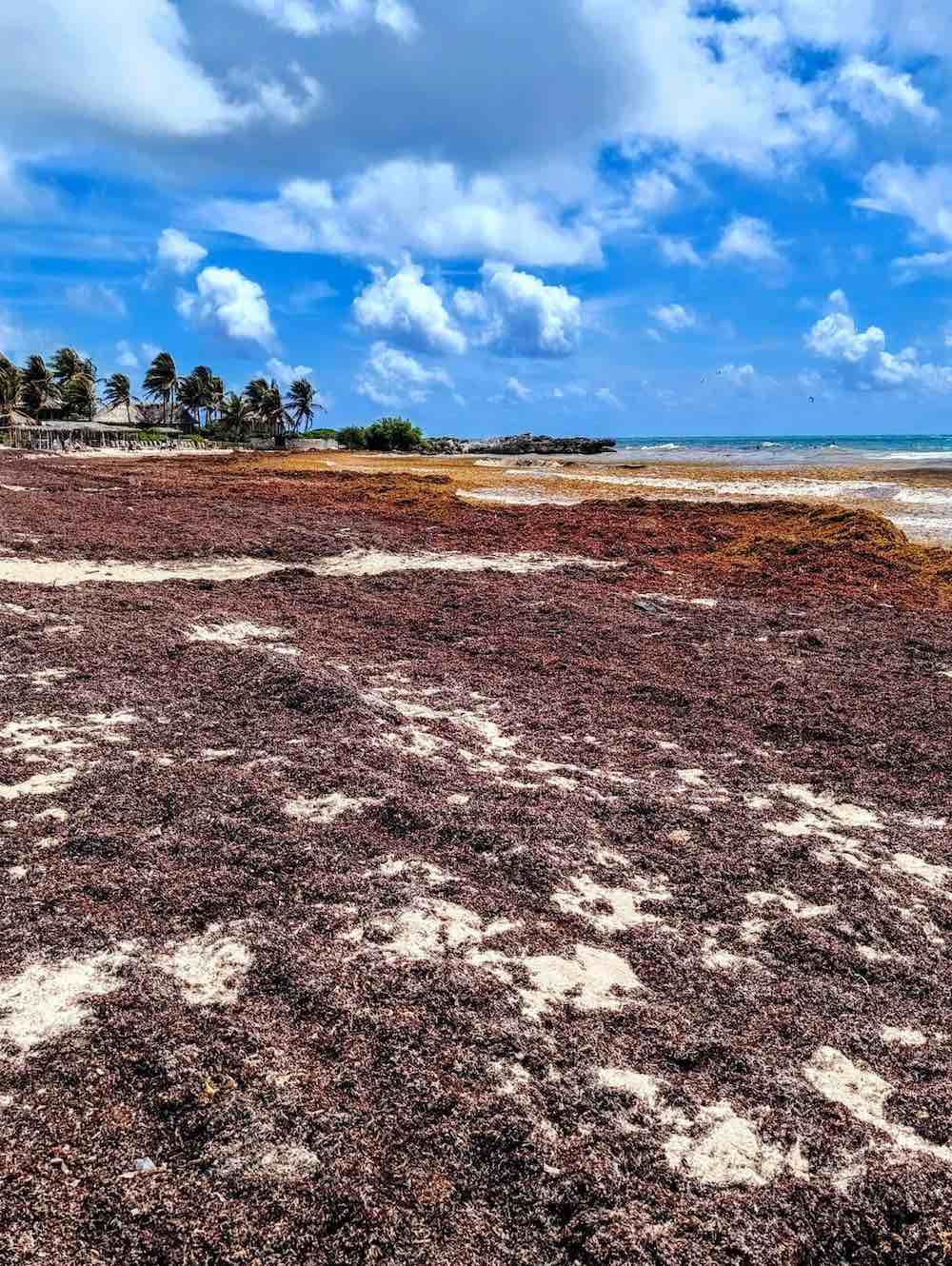
Over the past 10 years, I’ve personally walked the beaches of Mexico’s Caribbean coast during seaweed season many times. Certain beaches have more sargassum seaweed than others.
This report is from my personal trips to Cancun and Riviera Maya in 2025 as well as up-to-date research by local experts.
It includes tips on planning the best beach vacation and how to find the best beaches for swimming, even during the height of seaweed season in Cancun.
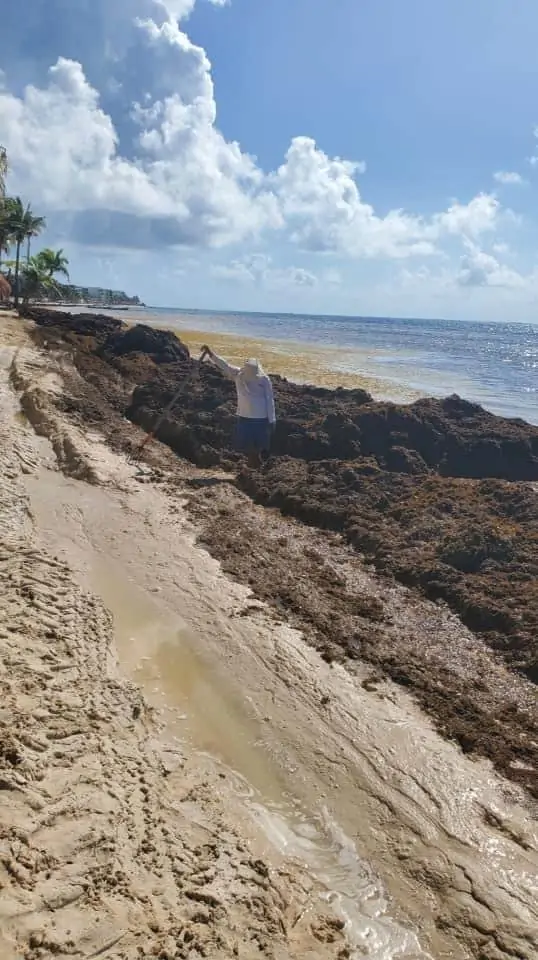
Note: This is a recurring post updated with original photos, sargassum seaweed maps and information on seaweed conditions and the status of the current seaweed problem in Cancun, Playa del Carmen, Cozumel, Puerto Morelos, Isla Mujeres, Akumal and Tulum.
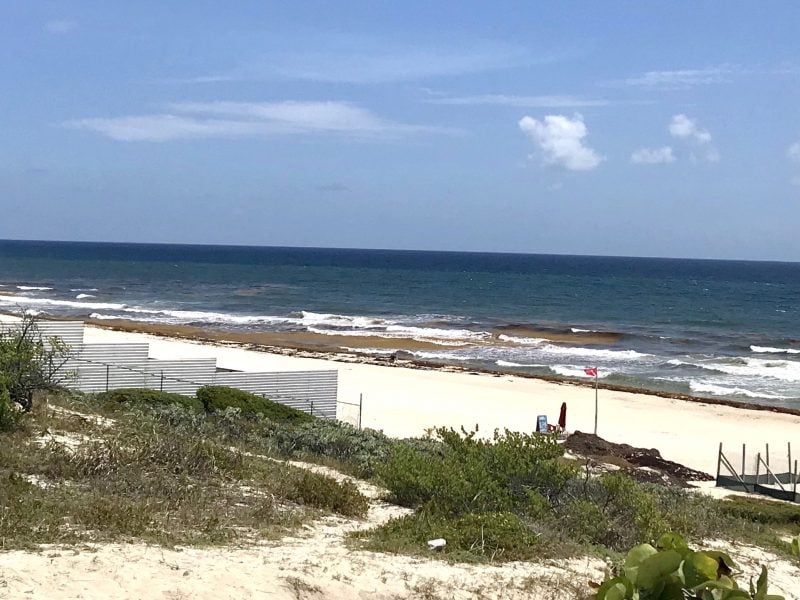
Cancun Seaweed Season Right Now – A Quick Snapshot
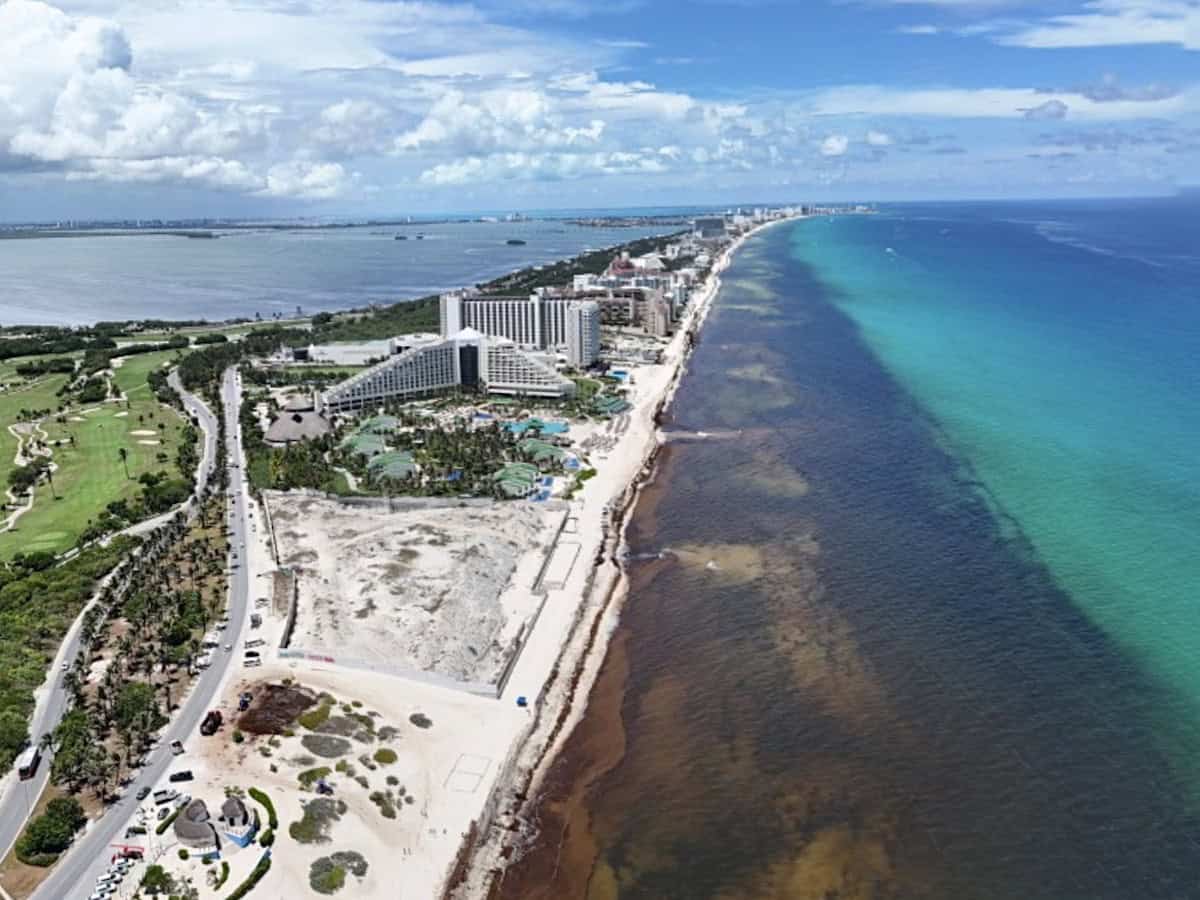
August 25, 2025: Sargassum Watch System reports that, in September 2025, Cancun and Riviera Maya should expect continued sargassum levels higher than in past years, though there may be some moderation compared to the peak levels seen in July. Conditions will be heavily shaped by shifting winds and ocean currents.
May 28, 2025: 28 of the 100 monitored beaches in Quintana Roo were classified under a Red Alert for excessive sargassum seaweed by the Sargassum Monitoring Network. Tulum, Playa del Carmen, Puerto Morelos and the east coast of Cozumel were the most impacted.
April 2025: The total amount of sargassum seaweed is up 40% above the June 2022 peak, making 2025 the new record year according to satellite observations by the University of South Florida.
But increases in the Gulf of Mexico and western Caribbean Sea are not as high as in Eastern Caribbean and West Atlantic where they’re 200% higher than historical records.
March 2025: Large amounts of sargassum seaweed have already begun to arrive on beaches in the Mexican Caribbean in March. However, landings have mostly been south of Cancun and Playa del Carmen.
Sargassum mats are drifting into the Caribbean through the Lesser Antilles, with the western Caribbean’s sargassum headed to the Gulf of Mexico.
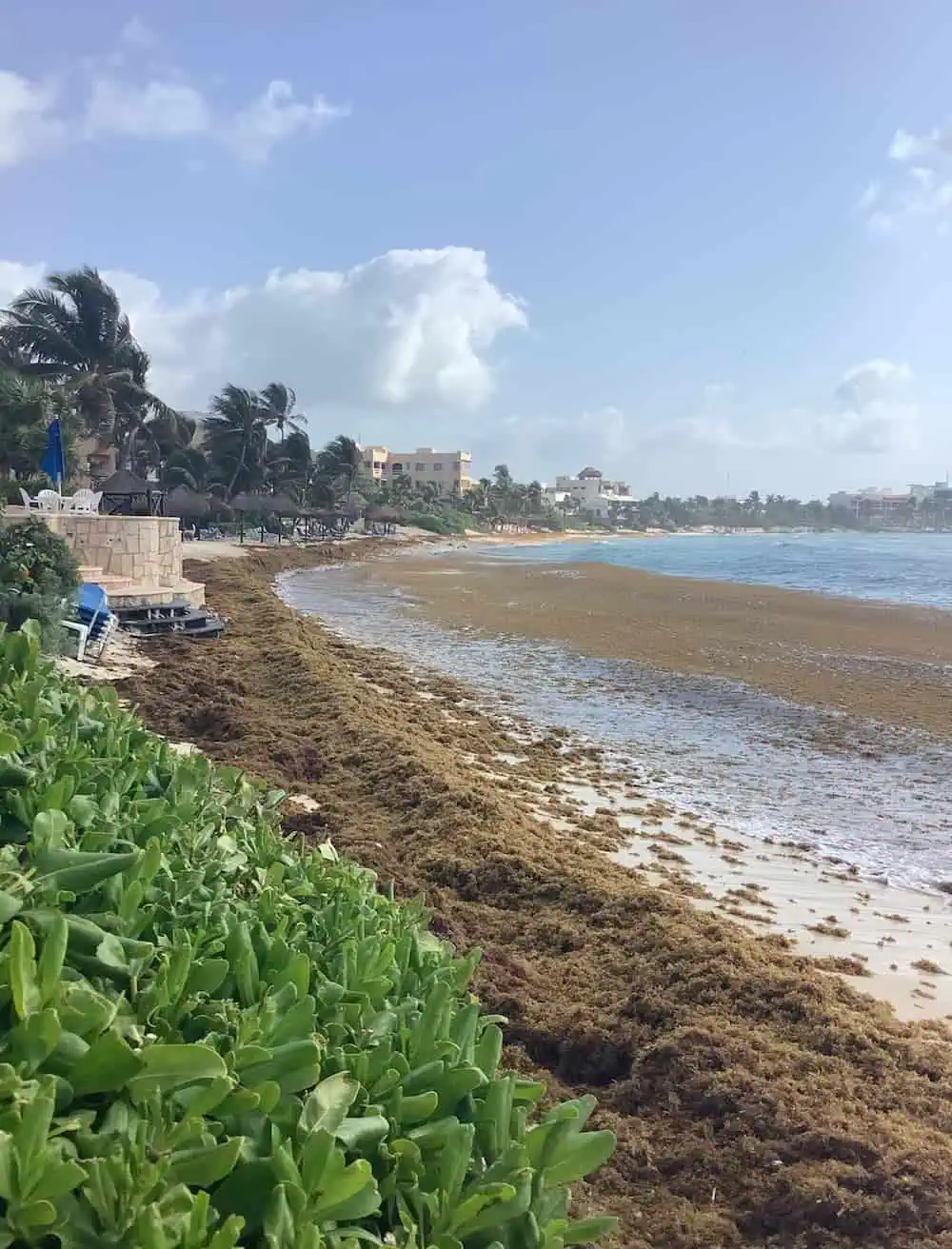
December 2024: The University of South Florida satellites observed a significant increase in the amount of sargassum in the tropical Atlantic. The amount of seaweed surpassed the 75th percentile of the past 13 years, strongly indicating that 2025 may be another major year for sargassum.
However, much depends on ocean and wind currents.
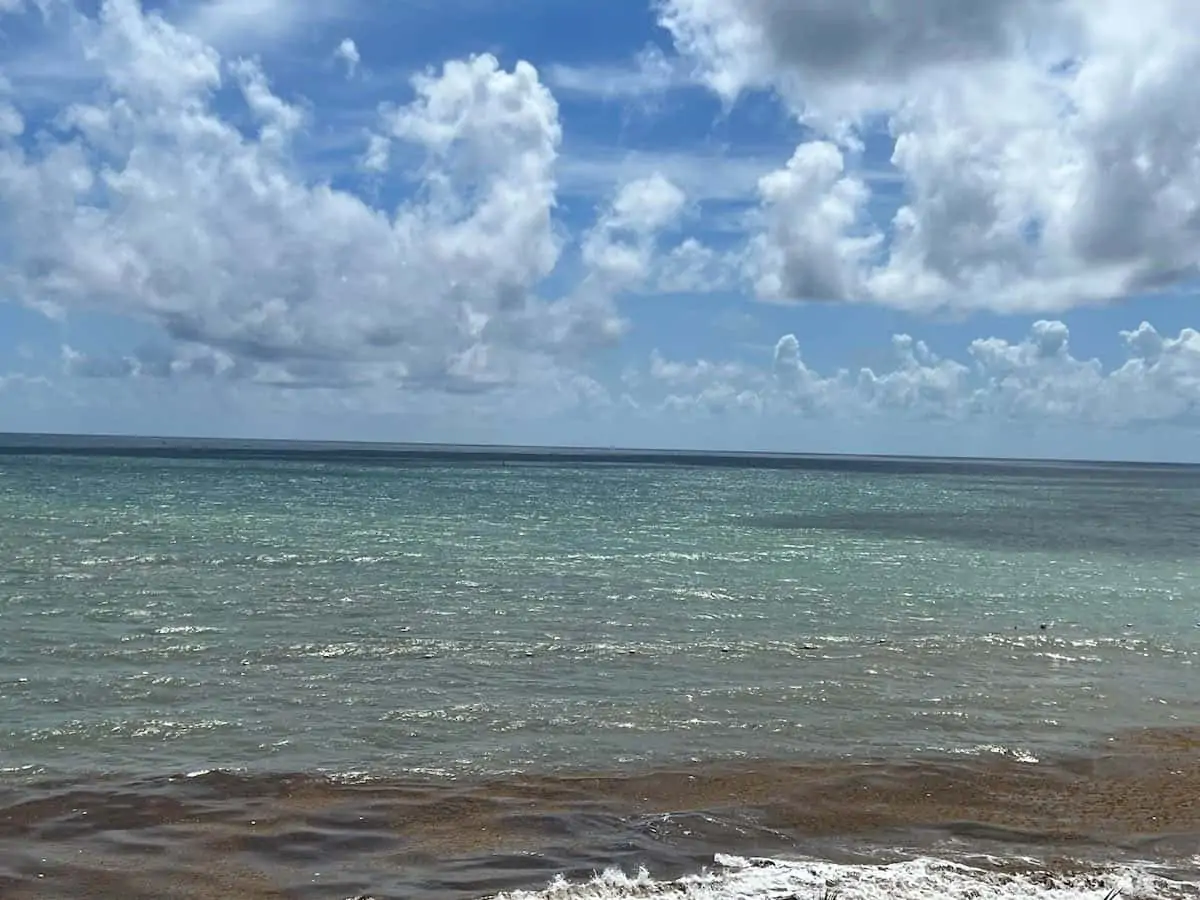
Sargassum Seaweed Facts
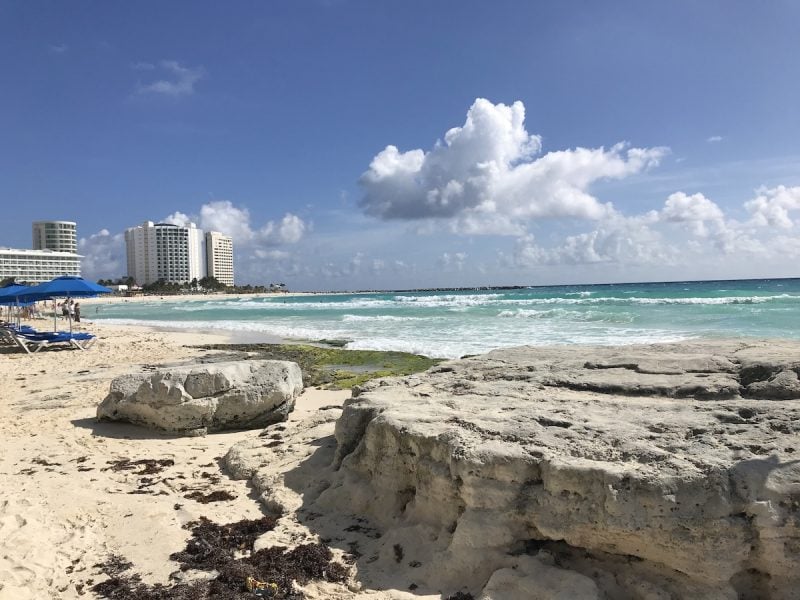
What exactly is sargassum seaweed and why is it a problem?
Sargassum (also known as sargazo and sargasso) is a type of brown algae that generally lies in the open ocean in the Sargasso Sea in the North Atlantic.
Wrapped by ocean currents, this mat of seaweed floats on the surface of the water. It serves as a resting area and spawning ground for a vast array of life from eels to sea turtles.
While sargassum seaweed is a natural phenomenon that has been occurring for centuries, the influx of sargassum in recent years have been larger, thicker and more widespread.
Since 2011, blooms of sargassum have been appearing in the tropics sweeping up from South America through the Caribbean along the coast of Mexico and into the Gulf of Mexico and Florida.
The summer of 2018 witnessed the worst influx of sargassum brown algae in recent history. In 2022, the seaweed problem was equally as bad.
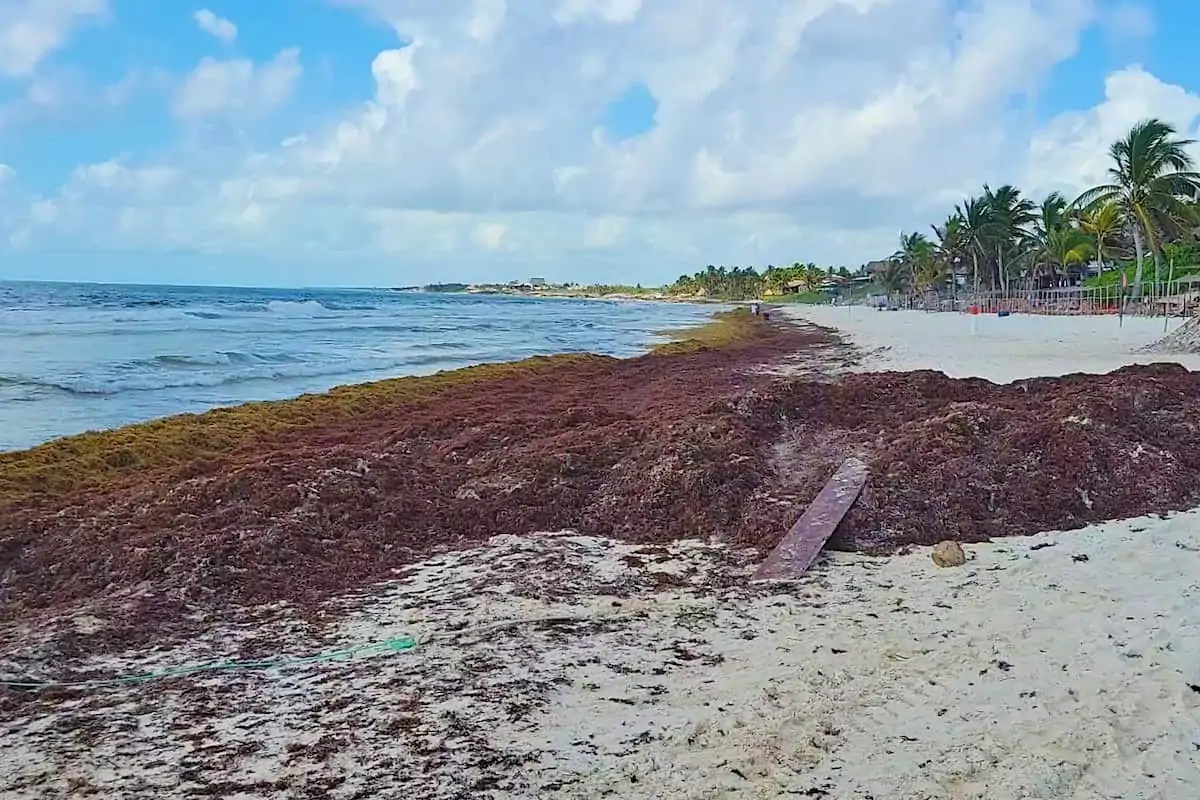
The quantity of the sargassum seaweed combined with differences in the composition of the seaweed itself, poses problems.
Large quantities of seaweed float on the surface of the water, wash up on beaches, trap marine life in the seaweed itself and use up the oxygen that fish need to breathe.
Various strategies — from raking it manually to using barriers to catch the sargassum before it reaches the shore — have been devised to try to deal with the unprecedented waves of seaweed that have engulfed regions of the Caribbean and Mexico in 2015, 2018, 2019, 2020, 2021, 2022, 2024 and 2025.
According to the Sargasso Sistema de Monitoreo de Sargazo Recolectado (SIMSAR) 1,465.54 metric tons was collected in May 2025 alone.
Is it Dangerous to Swim in Sargassum Seaweed?
Sargassum seaweed in itself doesn’t pose a problem, says Dr. Jeffrey Rapaport at Holy Name Hospital in Teaneck (Emeritus head of Dermatology).
Instead, it’s what the seaweed harbours that can cause skin irritations and other risks.
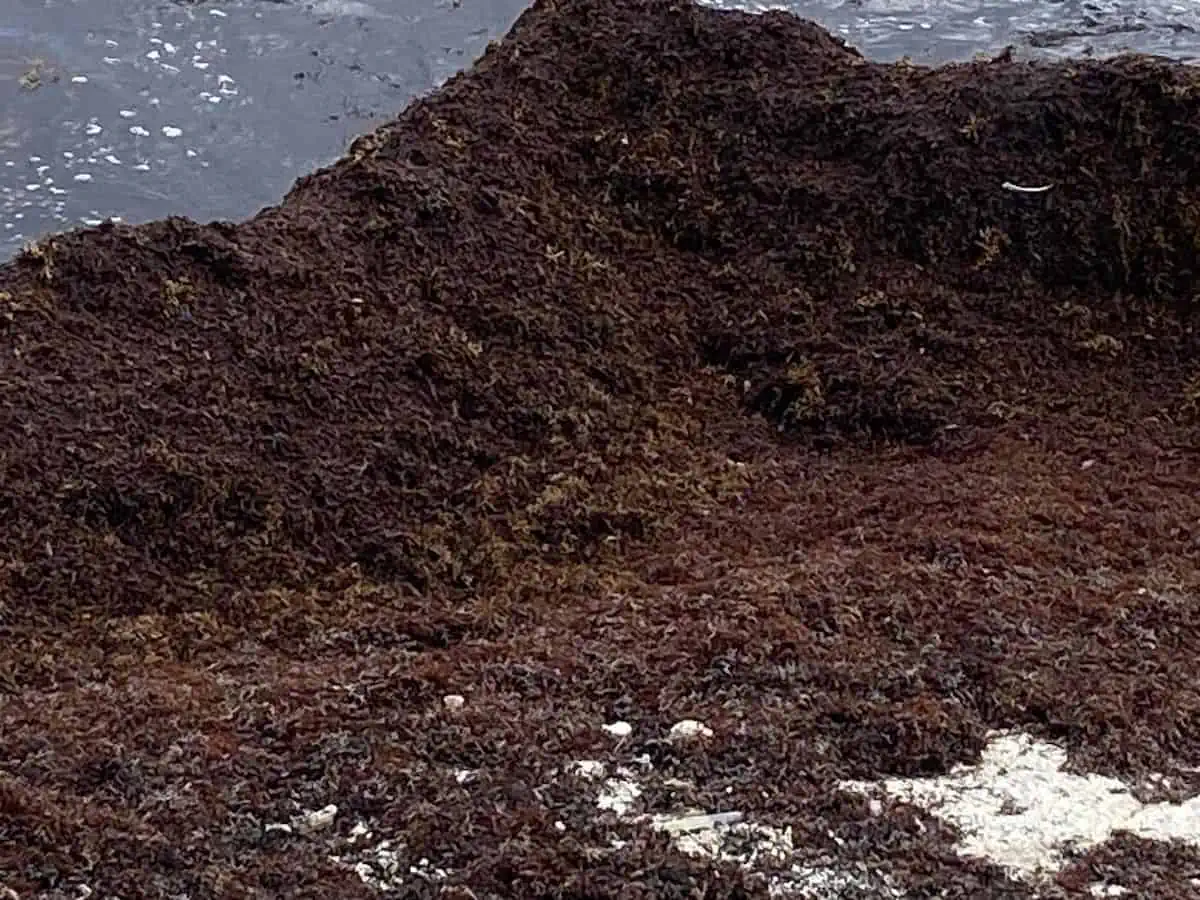
The seaweed when floating at the top of hot, shallow waters, can start to play host to microbes and strains of bacteria the skin is not accustomed to coming in contact with.
Also, you have to remember that fish normally use sargassum as a breeding grounds — leaving toxins and eggs in seaweed.
Sargassum can also contain sea lice and jellyfish.
With freshwater as well as saltwater swimmers should watch out for the growth of Cyanobacteria (which can normally be seen changing the water’s colour to light green).
Cyanobacteria can release neurotoxins, which not only can affect the skin but can cause the death of neurons that control most of the muscles and movements in your body.
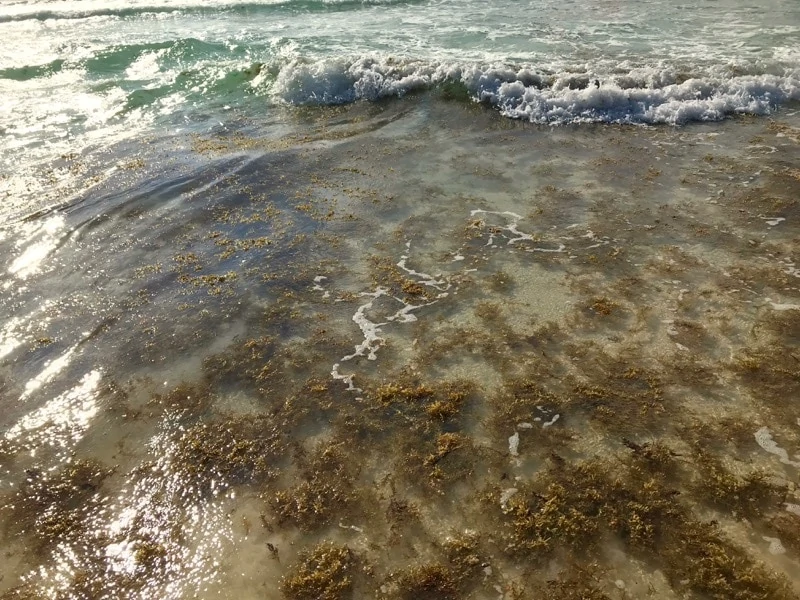
Another risk occurs when sargassum seaweed gathers in large quantities, washes up on beaches and begins to decompose.
It releases hydrogen sulfide gas, or H2S, a colourless, poisonous gas with an unpleasant rotten-egg odor,
According to Eric Najarro, Administrator at the Dr. Otto Rodriguez San Pedro Polyclinic II in Belize, inhaling small doses of the gas can trigger irritation of the eyes, respiratory issues and nausea, especially among at-risk people such as those with asthma, the elderly, infants and pregnant women.
Certain animals, especially dogs, are also sensitive to the inhalation of hydrogen sulfide.
Another health risk to swimming with large quantities of sargassum seaweed is the potential for skin irritations and rashes.
So if you’re wondering if it’s safe to swim in sargassum seaweed, according to the experts I’ve consulted, it’s not advisable.
Note that red tide and sargassum seaweed are two different problems. A red tide is a bloom of algae that discolours coastal waters and releases dangerous toxins.
Eating shellfish or other seafood during an algal bloom is harmful to humans.
When is Seaweed Season in the Caribbean and Mexico?
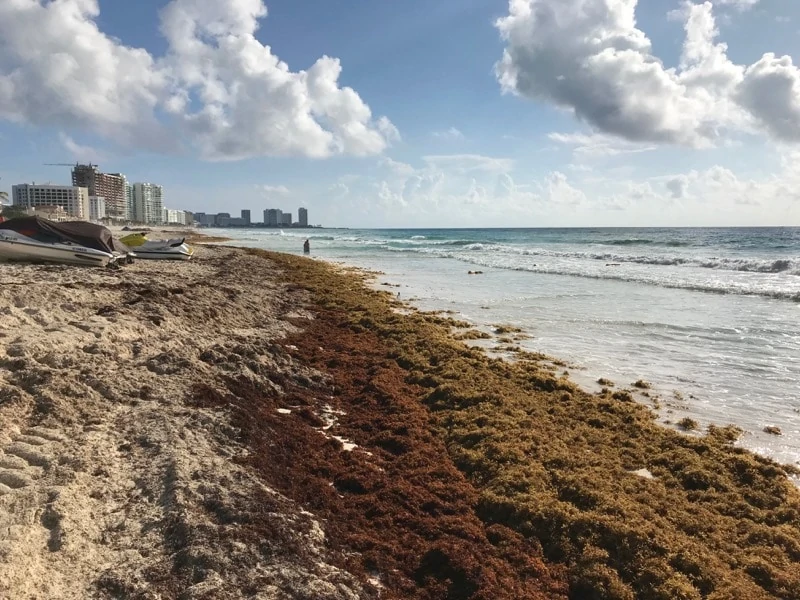
In the Caribbean, seaweed season is generally May to October. The worst time for seaweed in Cancun, the Dominican Republic, Trinidad & Tobago and much of the Caribbean is during the summer months.
Looking for vacation ideas on Caribbean islands not affected by sargassum seaweed? Check out our Guide to Caribbean Beaches without Sargassum Seaweed.
The seaweed season in Cancun is generally over by the end of October. However, some towns such as Puerto Morelos sometimes continue to receive sargassum seaweed past that date.
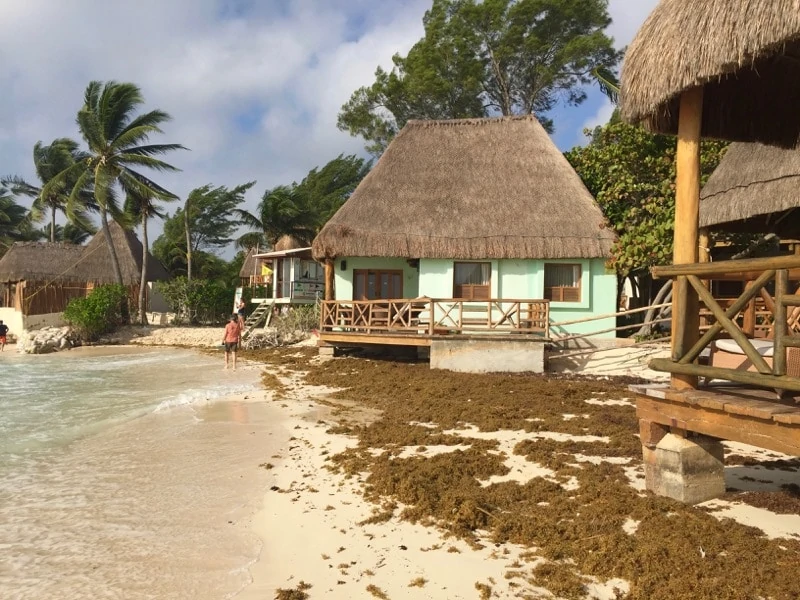
However, the state of Quintana Roo has been working on strategies to cope with the seaweed problem.
In addition to aerial surveillance, they have issued contracts to hire companies to collect and dispose of the seaweed.
Seaweed Conditions in Cancun
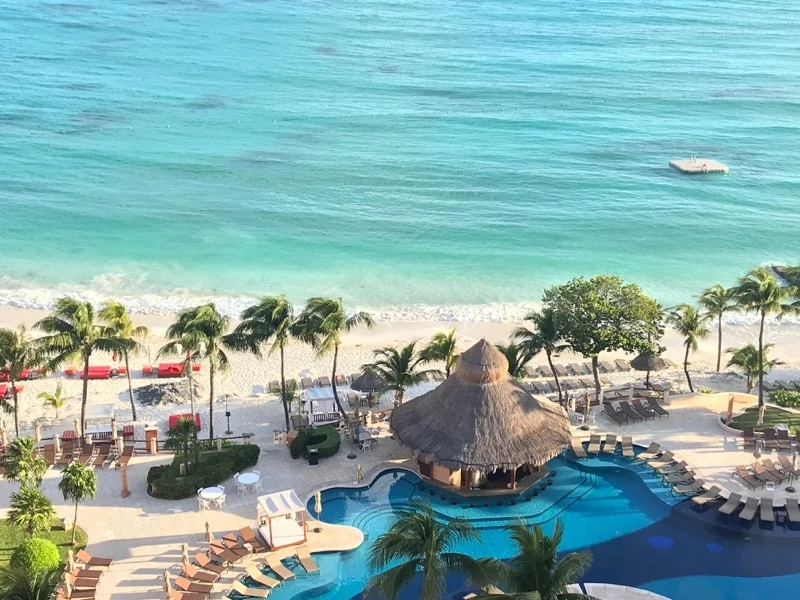
often no sargassum at the Grand Fiesta Americana Coral Beach Cancun.(Credit: Michele Peterson)
The quantities of seaweed in Cancun and along the Caribbean coast will vary depending upon ocean currents, the size of the sargasso seaweed mat, seasonality, ocean currents and wind conditions.
If you want to avoid the worst time for seaweed in Cancun and reduce the likelihood of it ruining your vacation, it’s worth considering which beaches to choose for your vacation.
For example there can be large quantities of algae in Petempich Bay, in Puerto Morelos, Recodo Beach, in the municipality of Solidaridad (Playa del Carmen), as well as Punta Mosquitos on Holbox Island.
Yet the rest of the coast can be relatively clear.
Where in Cancun is There No Seaweed?
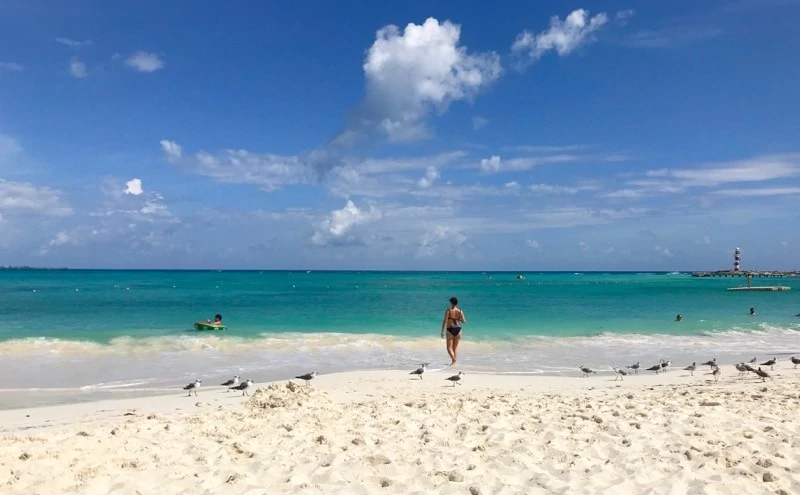
The best bet for beaches near Cancun with no seaweed is to head to the island of Isla Mujeres or to the leeward coast of Cozumel by ferry.
Beautiful Playa Norte (north beach) on Isla Mujeres is almost always clear of seaweed. Many of the hotels on the southwest coast of the island are also seaweed free.
We just returned from the newly-opened Impression Isla Mujeres by Secrets and loved its small private beach.
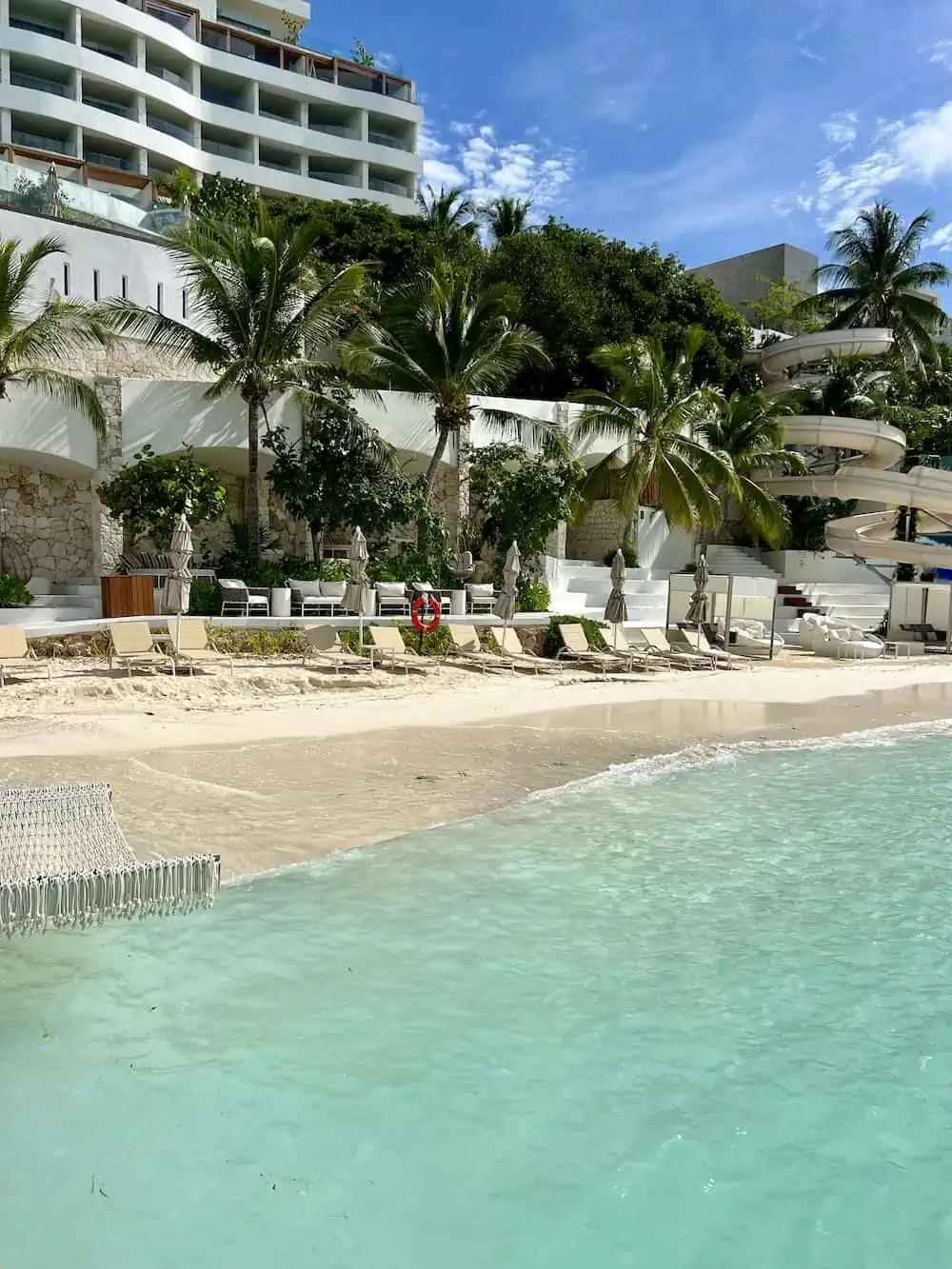
For more information on this all-inclusive, adults-only luxury resort, read our full review of Impression Isla Mujeres.
Another option is Playa Mujeres on the mainland north of Cancun. It is usually protected from seaweed inundations by Isla Mujeres.
Isla Contoy and Holbox are also generally free of sargassum seaweed.
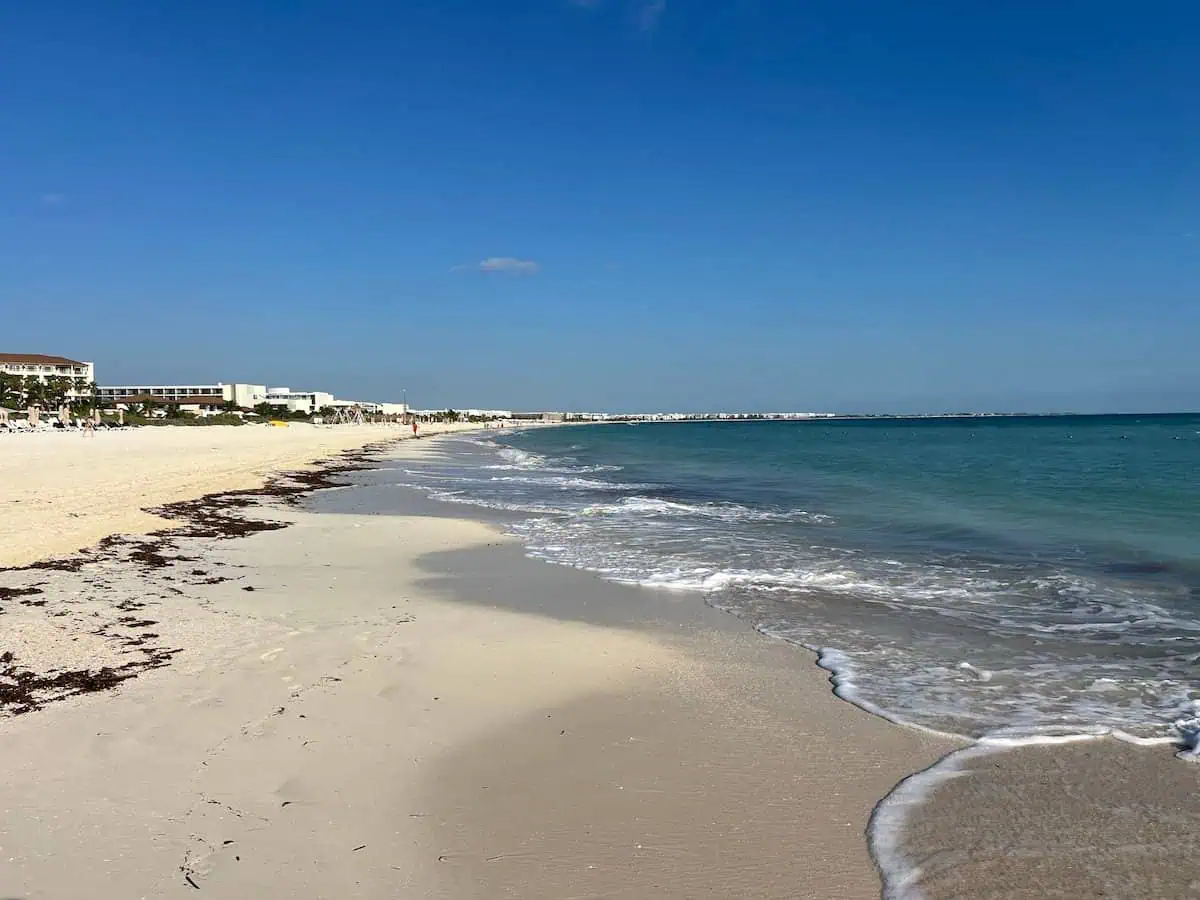
On the mainland, Coral Beach stretches along the northern shores of what’s known as Punta Cancun or the most northerly point of the Cancun Hotel Zone.
Next door at the Grand Fiesta Americana Coral Beach Cancun Resort & Spa, the private beach is often clear of sargassum. It features soft white sands and clear turquoise waters.
However wind and ocean currents can change and seaweed conditions at Grand Fiesta Americana Coral Beach Cancun can change quickly.
VERIFY SEAWEED CONDITIONS BEFORE YOU TRAVEL.
An advantage of Coral Beach is that the waters are calm and the entry is gradual with no steep drop-off. This makes it ideal for those who aren’t expert swimmers.
In my opinion, this is one of the best beach in Cancun for swimming.
Best Cancun Beaches Without Seaweed – Playa Gaviotas and Playa Gaviotas Azul
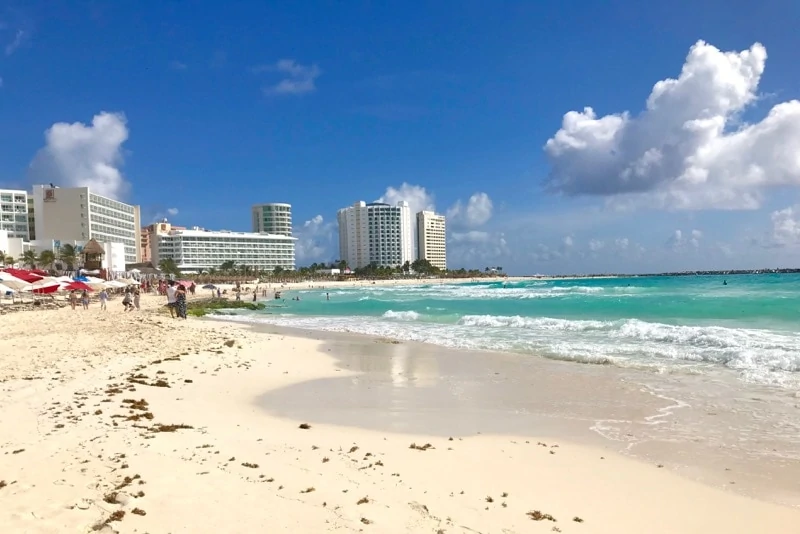
One of the most popular public beaches in Cancun, Playa Gaviotas Azul is located at the northern tip of the hotel zone.
Beach access is between Coco Bongo and the Mandala Beach Club opposite Hooters via a narrow alleyway. Current seaweed conditions at Playa Gaviota Azul depend on the intensity of the ocean currents.
Most small clumps of seaweed on the sand are raked up by hotel staff. There is often very little sargassum seaweed floating offshore. But this is not always the case.
However wind and ocean currents can change and seaweed conditions can change quickly.
The major hotels on these beaches include the all-inclusive Krystal Cancun and the Hyatt Ziva Cancun at the point of the peninsula. If you stay at a budget hotel in Cancun with a beach shuttle, this is where you’ll be dropped off.
VERIFY SEAWEED CONDITIONS in CANCUN BEFORE YOU TRAVEL.
Best Cancun Beaches Without Seaweed – Playa Delfines / Dolphins Beach
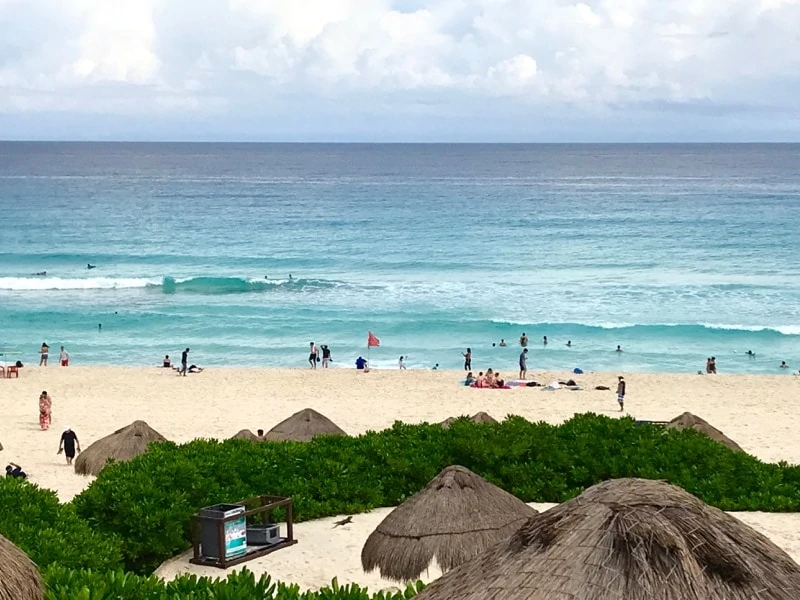
This long, wide public beach at the southern end of the Hotel Zone is known as Playa Defines. It’s one of the most popular beaches in Cancun.
You’ll also see line-ups of people waiting to get a photo-op in front of the CANCUN sign.
The amount of seaweed on Playa Delfines varies considerably from week to week. See below for a photo of what it looked like in 2018.
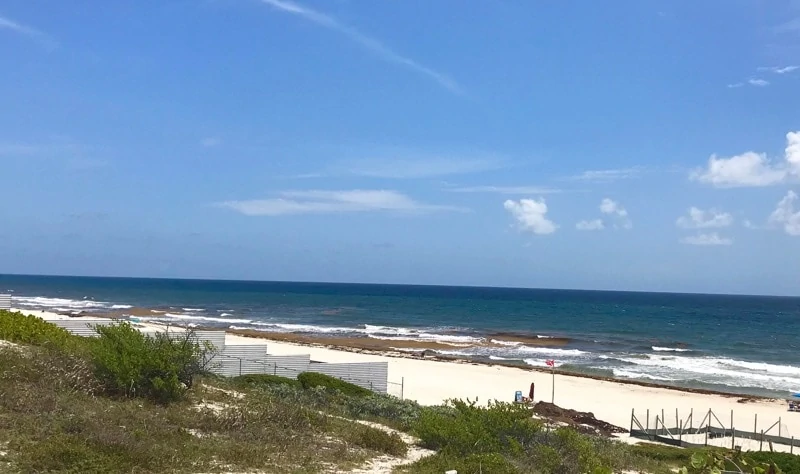
However wind and ocean currents can change and seaweed conditions can change quickly.
If there is a lot of seaweed at Playa Delfines, a good option is to take a ferry to Isla Mujeres or Isa Cozumel. The leeward beaches on those islands almost always have no sargassum seaweed.
Check our list of the best all-inclusive resorts in Cancun Riviera-Maya.
Current Cancun Seaweed Conditions – Sargassum Forecasts for 2025
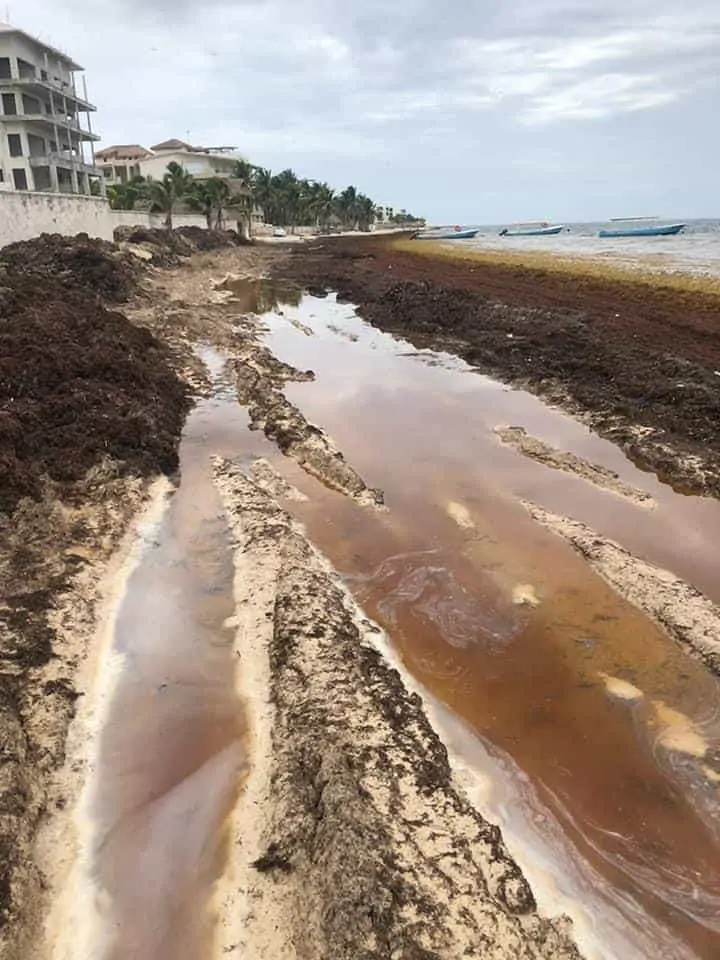
Seaweed forecasts by the experts have historically been quite accurate.
A report by Brigitta Ine van Tussenbroek, an ocean researcher from the Institute of Marine Sciences at the National Autonomous University (UNAM) stated that because Mexico’s Caribbean coast faces east it’s particularly susceptible to mass landings.
For seaweed season in 2025, the Sargassum Early Advisory System (SEAS) forecasting project showed several large floating masses of seaweed in the Atlantic between southern Africa and Brazil.
Whether it lands in Cancun, Chetumal, Tulum or the Riviera Maya depends much upon atmospheric conditions such as trade winds.
According to the University of South Florida’s Outlook of Sargassum blooms in the Caribbean Sea and Gulf of Mexico, based on offshore conditions, the seaweed forecast for 2025 suggests it will be a record-breaking Sargassum year.
So it’s wise to keep a watch on seaweed conditions as landings of sargassum can change from day to day.
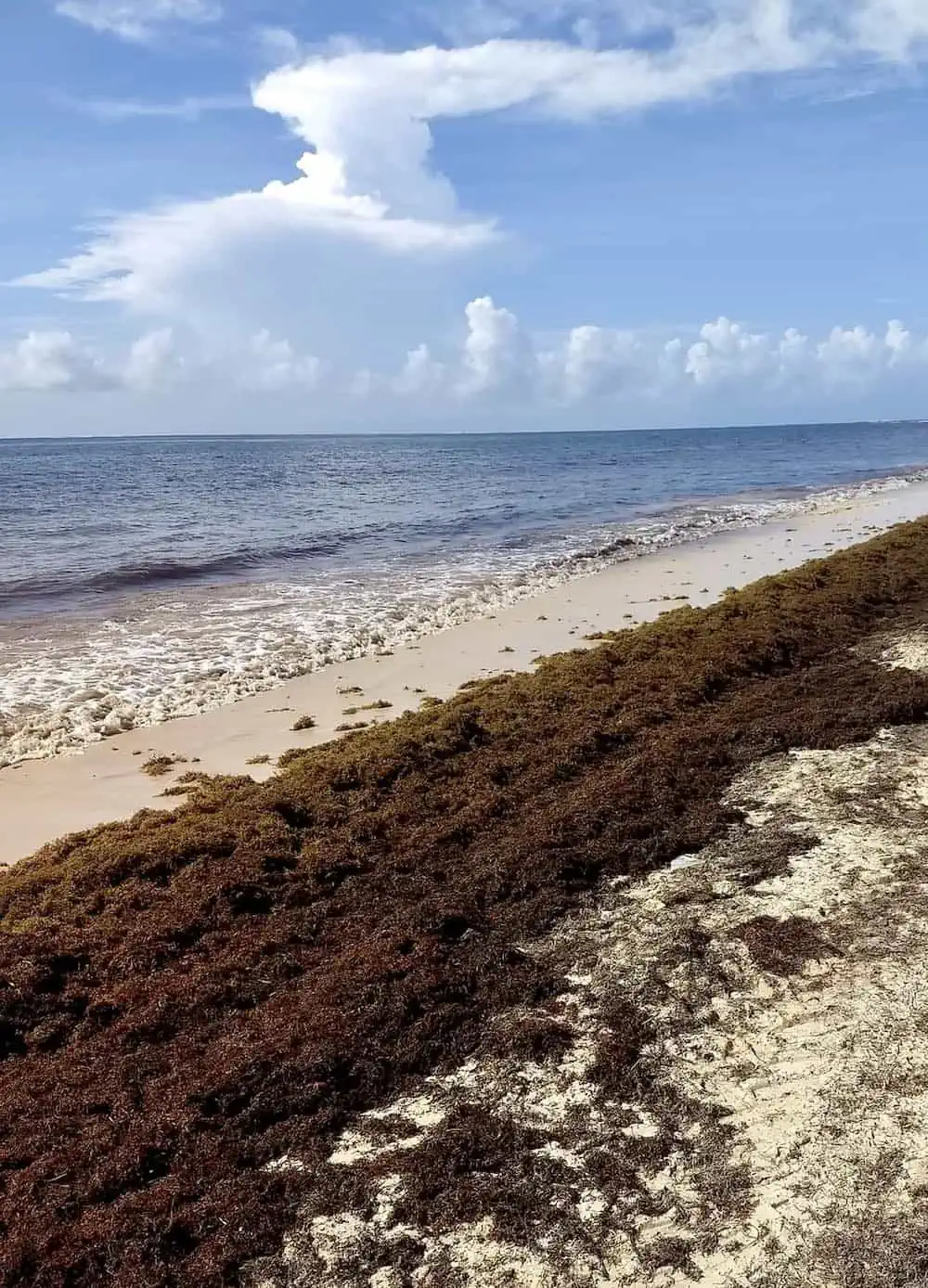
Current Seaweed Conditions in Tulum

How is the government dealing with the seaweed problem in Tulum, Playa del Carmen and Mexico’s Caribbean Coast?
When needed, the government of Quintana Roo issues an emergency declaration for the municipalities of Lázaro Cárdenas, Isla Mujeres, Benito Juárez, Puerto Morelos, Cozumel, Solidaridad, Tulum, Felipe Carrillo Puerto, Bacalar and Othón P. Blanco.
Declaring a State of Emergency allows local authorities to get funding to combat seaweed by removing accumulations and blocking it by various methods.
Tulum and Chetumal have often been hit the worst. But it’s important to note that from Tulum to Cancun seaweed conditions can change daily depending on tides and water temperature.
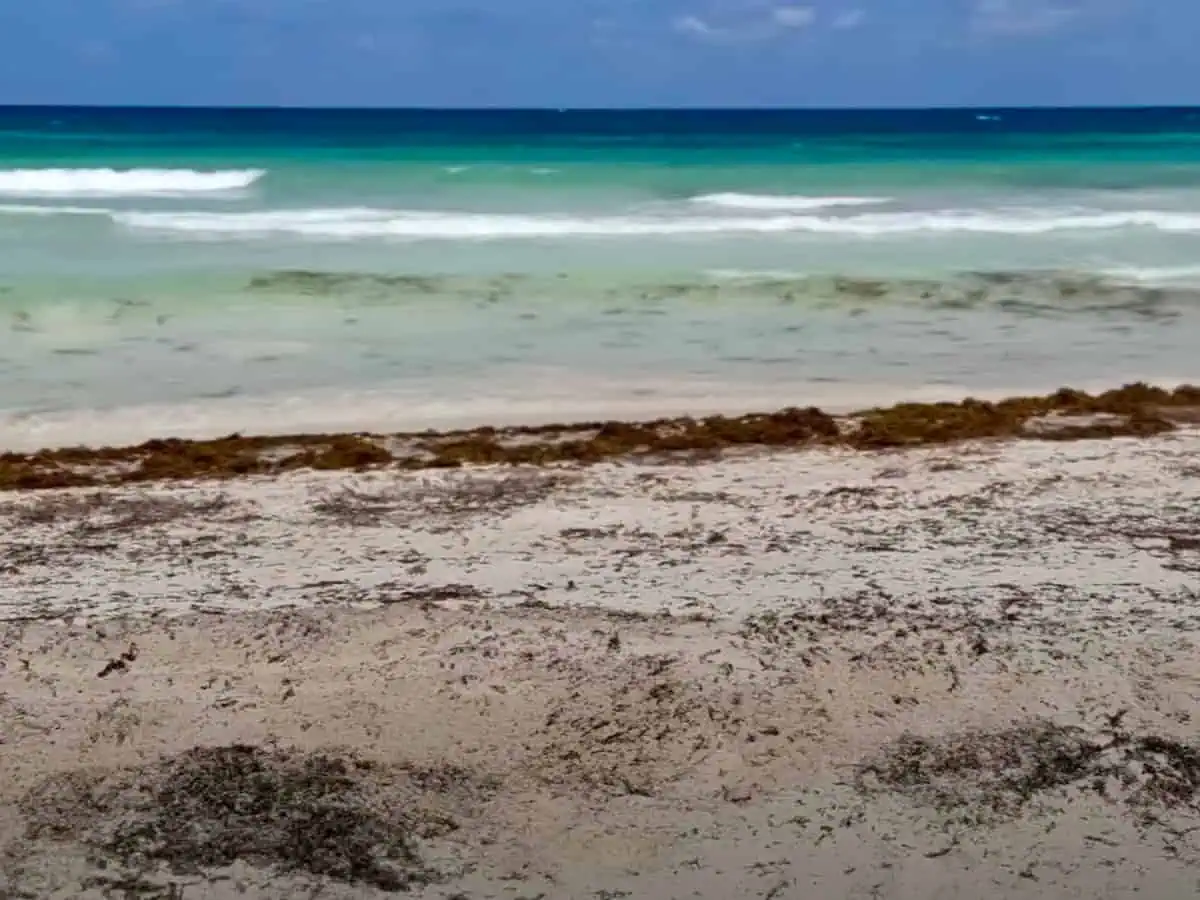
If sargassum conditions are bad on Tulum’s beaches, it’s worth trying the beach club at Caleta Tankah. The ocean here often has clear waters.
Or, head inland to Bacalar, a town set on a freshwater lagoon with spectacularly clear waters fed by underground cenotes.
Playa del Carmen Seaweed in 2025
The popular resort town of Playa del Carmen has been experiencing a double whammy of challenges in recent years.
The main problems are the erosion of its beaches and the influx of sargassum seaweed along the coast. Seaweed in Playa del Carmen has a tendency to get trapped and decompose.
It then smells and release dangerous gases such as hydrogen sulfide gas, or H2S, a colourless, poisonous gas with an unpleasant rotten-egg odor.
But the good news is that in 2025, authorities installed an offshore barrier that’s helping to block large mats of seaweed.
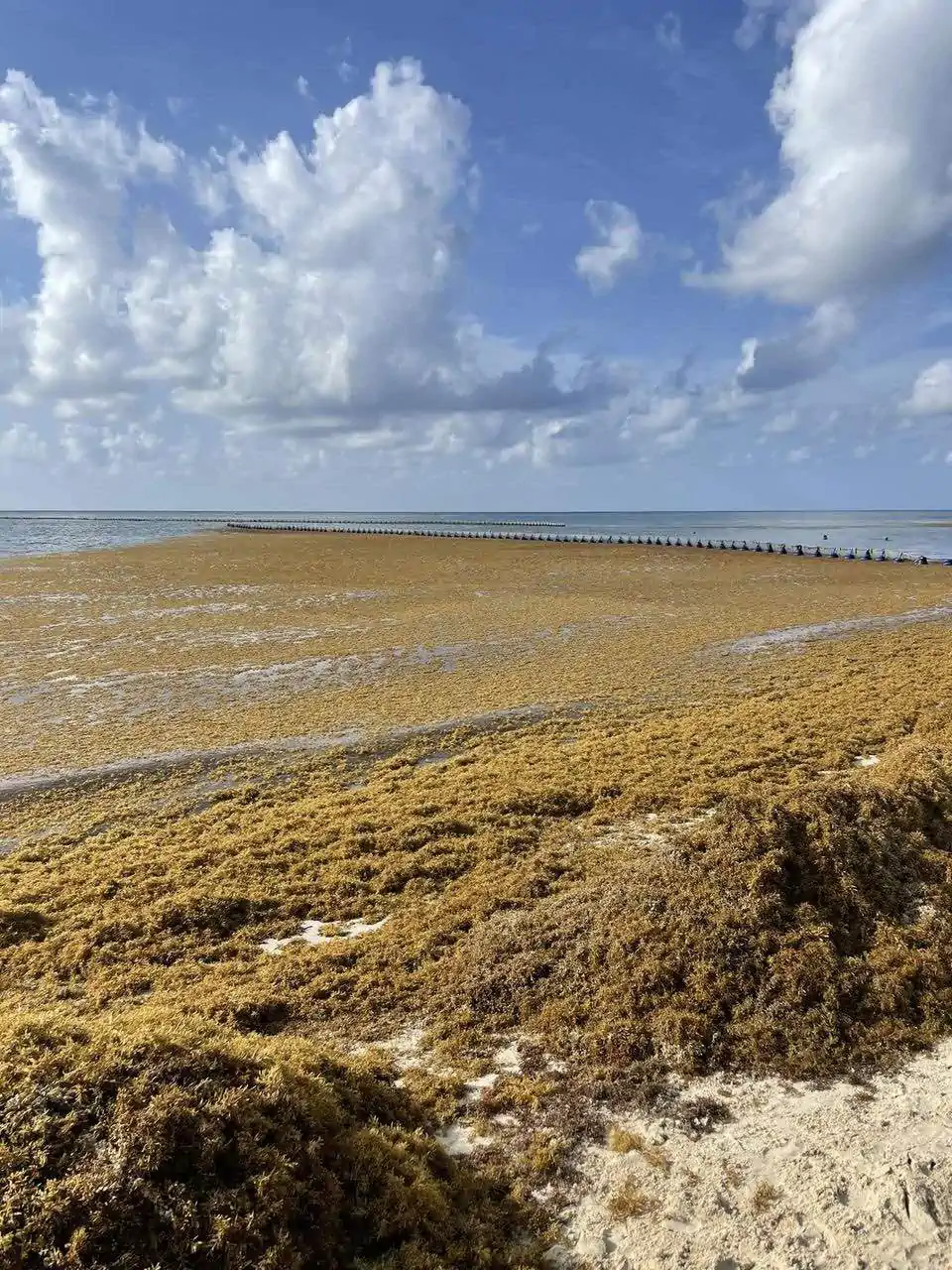
The seaweed season usually ends in October in Playa del Carmen.
But if you’re visiting Playa del Carmen in seaweed season, it’s possible to avoid seaweed problems in Playa del Carmen by staying at resorts that have created inland beaches.

Both the Xcaret Hotel Arte (adults-only) and Xcaret Hotel (family-friendly) have created several inland beaches so guests can avoid major sargassum mats.
Another all-inclusive resort in Playa del Carmen, Impression Moxché by Secrets, also created an artificial inland beach where you can enjoy soft sand and clear water in seaweed season.
Further south, a fantastic all-inclusive resort without seaweed is the Hard Rock Hotel Riviera Maya in Puerto Aventuras. It’s one of the best places to stay in seaweed season in Cancun and Riviera Maya.
Here, the inland beach has no seaweed because it’s protected by a rocky breakwater. But the tidal pools allow fresh seawater to enter. The water is clear enough to snorkel among tropical fish and has an added bonus of being quite calm.
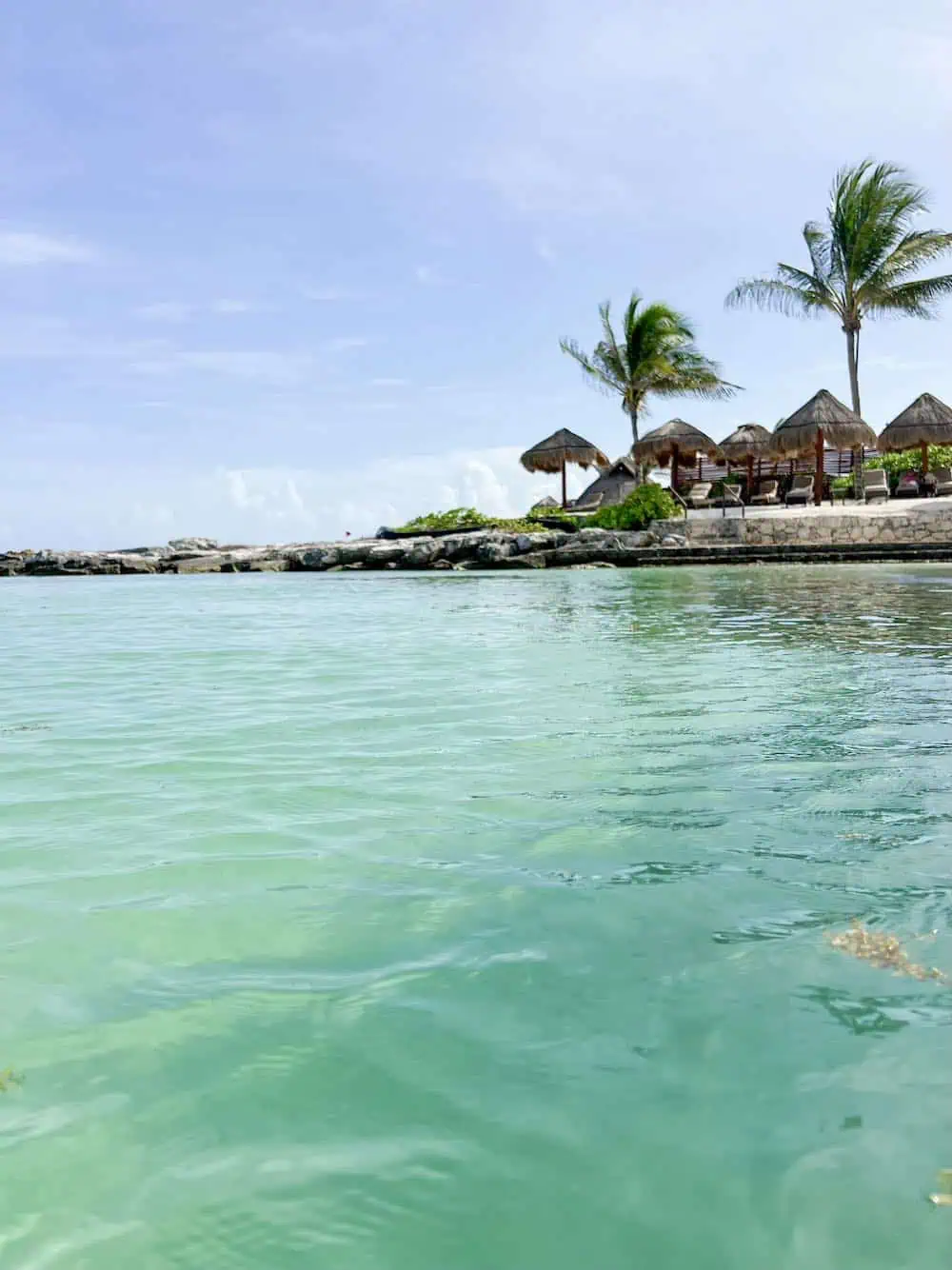
Any sargassum seaweed that manages to sneak into the beach zone is promptly removed by staff. So there’s no seaweed to accumulate and rot.
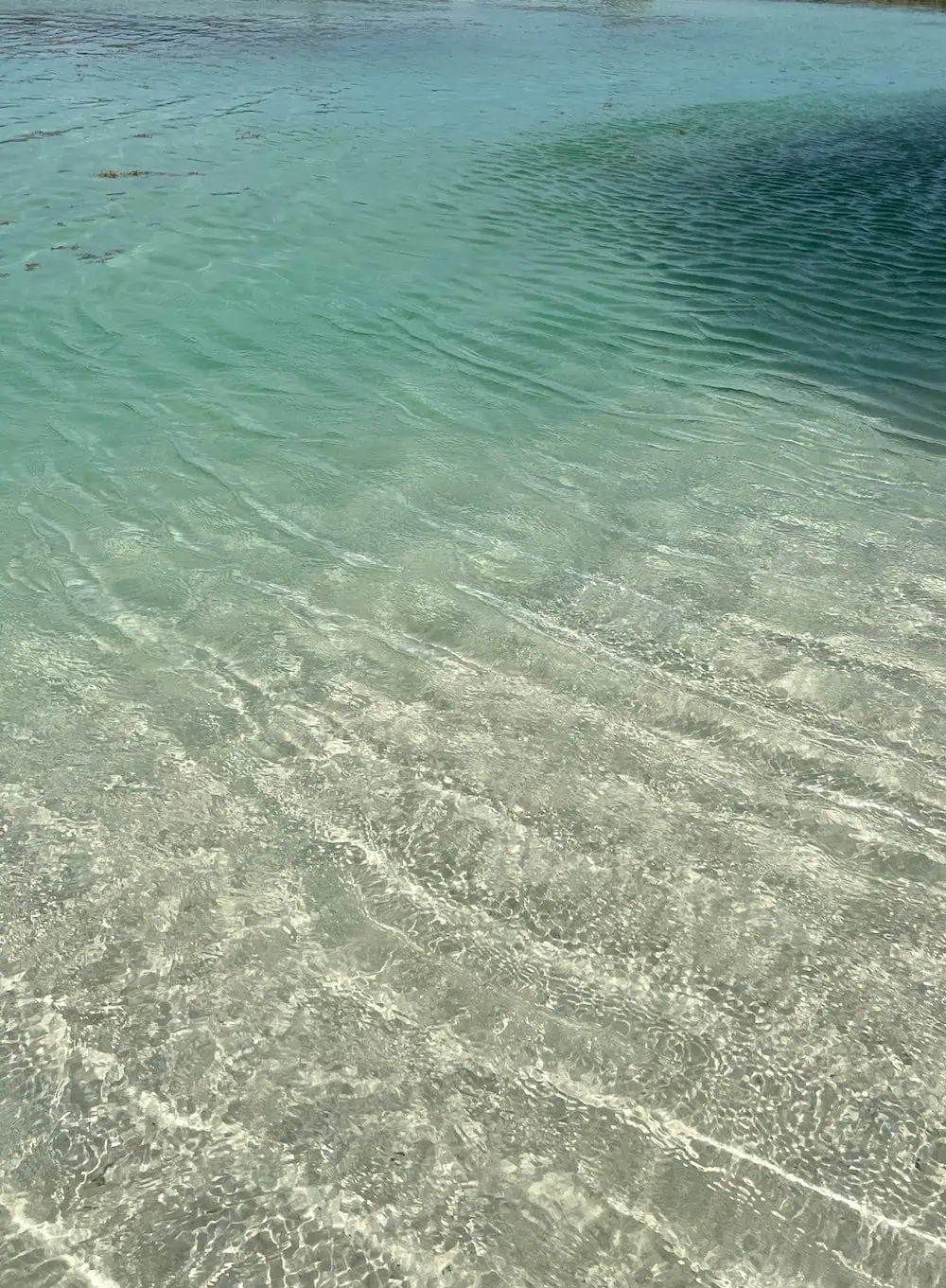
Sargassum Forecast for Seaweed Season in Mexico in 2025

In Mexico, sargassum seaweed season is generally between May and October each year.
If you travel to the Caribbean coast of Mexico outside of that time period you can generally avoid large mats of seaweed on the beaches.
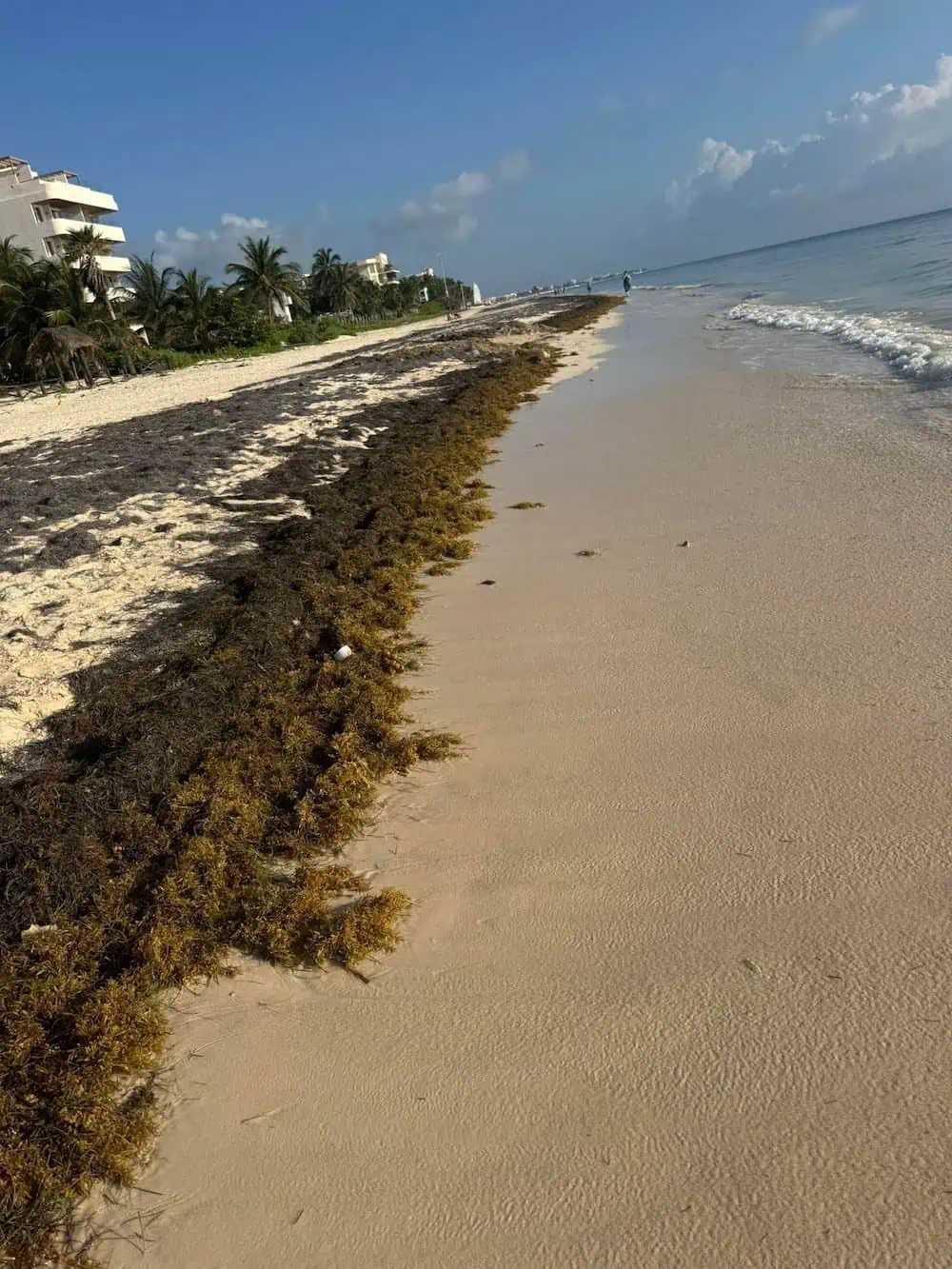
January 2025:
Based on offshore conditions satellite images analyzed by the University of South Florida, the seaweed forecast for 2025 suggests it will be another major Sargassum year.
By January 2025, sargassum had already started to land on certain beaches in the Mexican Caribbean such as Puerto Morelos.
Get the latest seaweed maps on the Red de Monitoreo del Sargazo Cancun Facebook Page .
June 2024:

July 2021:
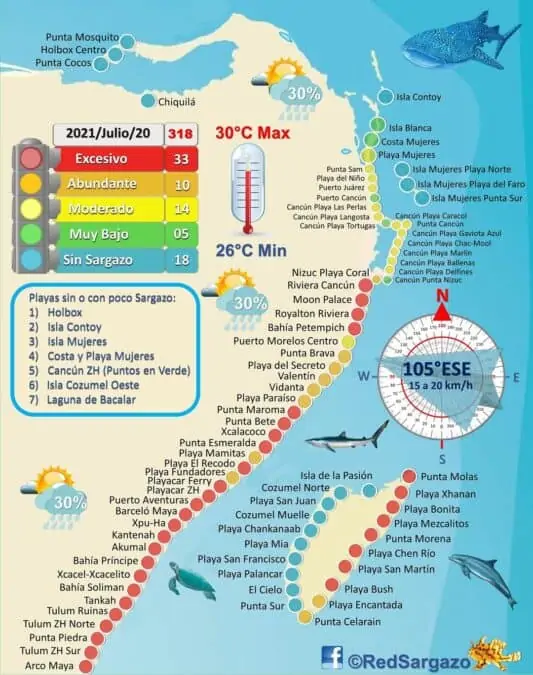
March 2022
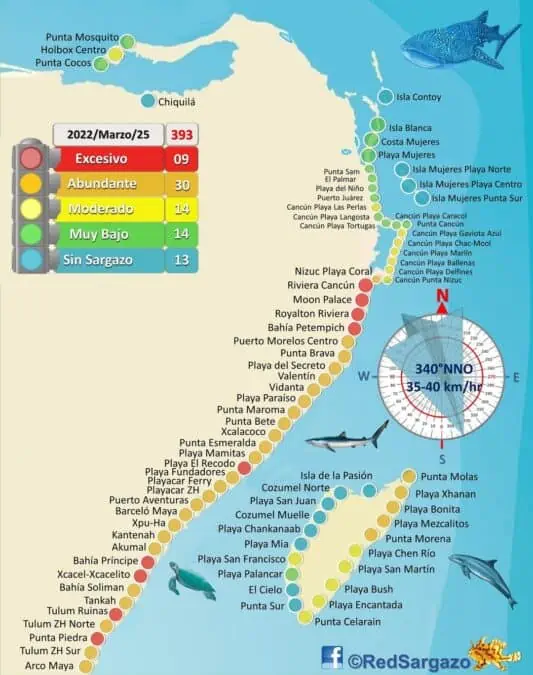
If you are planning a vacation during seaweed season (May to October), monitor current seaweed conditions throughout the Caribbean, Mexico and the Gulf of Mexico by consulting the following resources.
Sargassum Seaweed 2025 Forecast Resources
The resources will also help plan a beach vacation by providing forecasts on seaweed in 2025.
- Check the forecast at the University of South Florida’s Outlook of Sargassum blooms in the Caribbean Sea and Gulf of Mexico.
- Consult the Sargassum Early Advisory System (SEAS), a forecasting project based in Texas intended to help predict the movement of sargassum blooms. Originally created in 2013 to help with forecasting of the large Sargassum landings in Texas, by 2017 the SEAS project had expanded to provide forecasting for the Gulf Coast, Mexico, Grand Cayman, Jamaica, Haiti, Saba, the Dominican Republic, Puerto Rico and many other Caribbean islands. The SARGASSUM EARLY ADVISORY SYSTEM can forecast sargassum seaweed masses up to eight days in advance.
- Get seaweed maps, updates and a Seaweed Report from the Red de Monitoreo del Sargazo Cancun Facebook Page . This not-for-profit group is made up of engineers, biologists and other experts who are volunteering their time to provide monitoring expertise and services. They publish a map of areas affected by sargasso seaweed in Cancun, Riviera Maya, Cozumel and Tulum.
- Check Riviera Maya and Cancun Beach Webcams at Live Webcam to see live video frames updated every 15 seconds.
- Consult our article on Caribbean Beaches Without Seaweed for vacation options in Mexico and several Caribbean islands.
- Subscribe to the free A Taste for Travel newsletter for updates on the best beaches, seaweed conditions and other travel tips!
- Consider resorts at beach destinations on Mexico’s Pacific Coast where there is no sargassum. Popular beach destinations include Huatulco, Puerto Escondido and Puerto Vallarta.
FAQs
Seaweed season in Cancun is May to October so if you are visiting during those months in 2025 you could encounter sargassum seaweed on the beaches and/or in the water.
Based on the quantity of sargassum seaweed currently in the Atlantic, there could be a major seaweed problem in 2025 in the Caribbean Sea (affecting Cancun, Tulum and Playa del Carmen) depending on wind and ocean currents.
The amount of sargassum seaweed in Cancun varies by season and even daily. Generally the worst months for seaweed are July and August.
Tulum, Mexico has a history of receiving influxes of sargassum seaweed during seaweed season. Seaweed season is generally between May and October. Based on the large size of the sargassum mat currently in the Atlantic, experts forecast that Tulum could have a major seaweed problem in 2025, depending on ocean and wind currents.
More Posts About Cancun and Caribbean Beaches
Save to Pinterest!
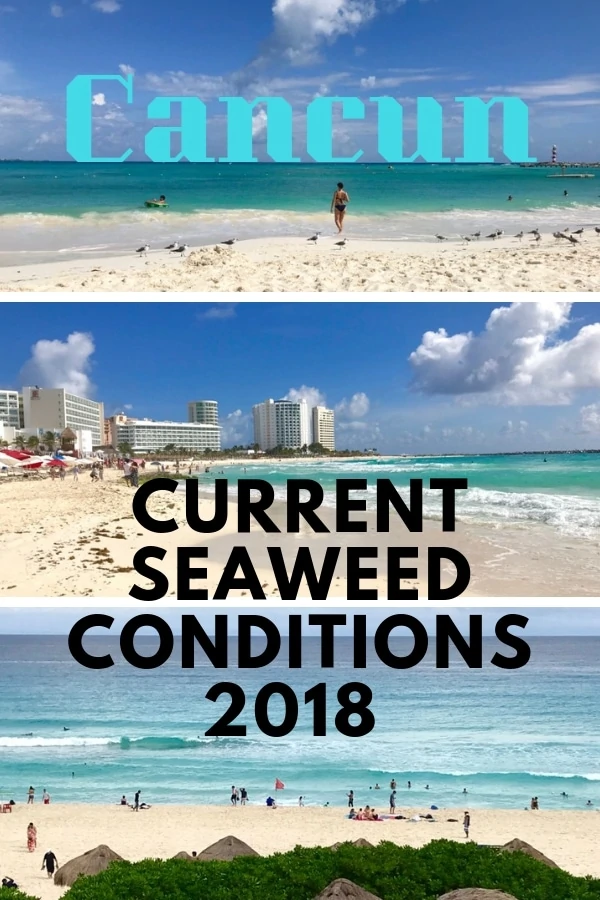

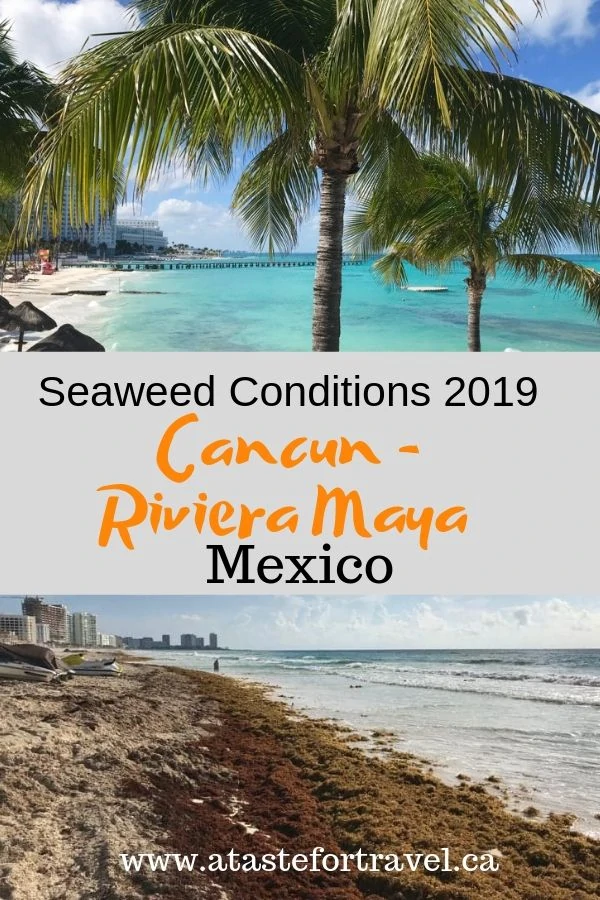
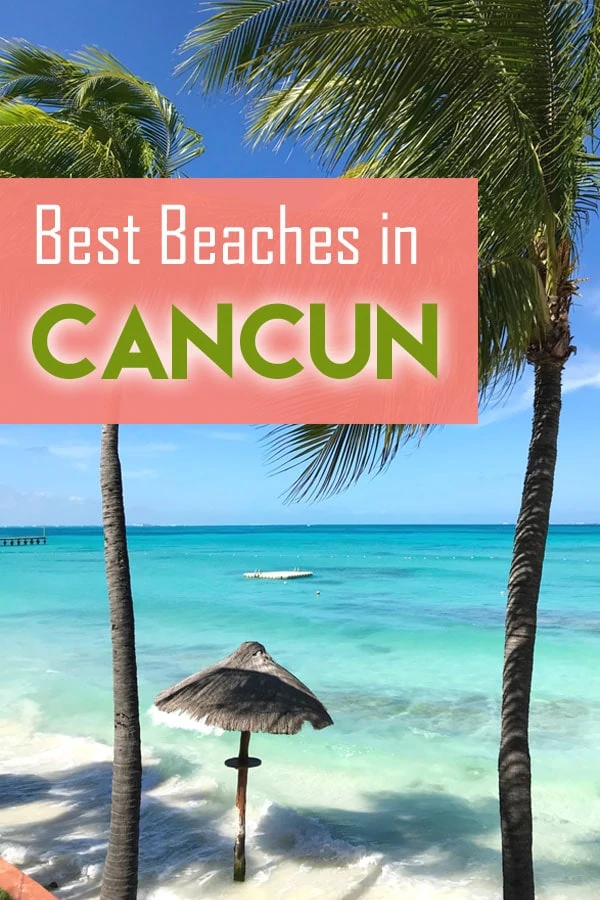
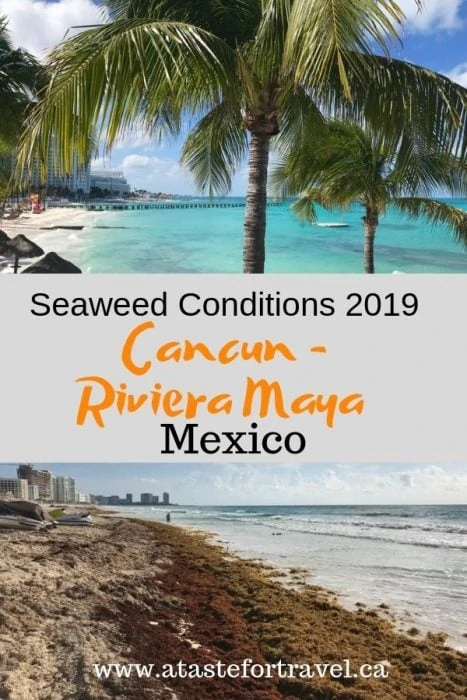



 Is a Cancun Day Pass to Dreams Playa Mujeres Worth It?
Is a Cancun Day Pass to Dreams Playa Mujeres Worth It?
Louis
In Cancun now Westin L&mar beaches are fine but lots of seaweed. We are able to find times in the day and sections along the beach to swim. Not ideal but if your coming to get away and relax you will be able to. If your main purpose is to have daily ocean swims u will be disappointed We will be back next year which will be our 6 year in a row.
Michele Peterson
Thanks so much for the update! It’s great to hear you’re finding some clear patches without seaweed to enjoy!
Angela Novigrod
Dear Michele,
Wow, thanks for all this info. I never heard of it before. Unfortunetlly I planned a surprise 4 day visit to PDC mid June for hubby’s bday. We are staying at the Grand Hyatt. I’m wondering if it is worth cancelling and planning for another time. I can’t imagine the smell is any fun, gag. The map above says yellow, so not sure how bad this is on the gross meter. Is this part of PDC hit hard? If so does the cleaning efforts correct the issue or is it a summer long problem in this location? Thanks. We do have 1 day tour planned. Thanks for your help.
Michele Peterson
Hi Angela What a great birthday surprise! The beach south of the dock in PDC gets hit often but it’s hard to predict what the situation might be in June as so much depends on water and wind currents. If it’s bad you can always hop across to Cozumel as the leeward beaches on the island rarely ( if ever) have seaweed.Closer to your travel date you can also check the Red de Monitorio site on Facebook for the latest conditions.
TH
I’ve just booked our first family vacation in years for late June in Cancun, and I’m now terrified it’s going to be ruined by sargassum. I should have done more research on the issue before buying non-refundable airfare.
We were really looking forward to spending time on the beach and swimming in the ocean. Now I have to figure out how to salvage it. We are staying in the hotel zone, at JW Marriott.
Michele Peterson
Try not to worry! Sargassum isn’t on the beaches every day and many times is quite light. If it does arrive, then you could take a short ferry to Isla Mujeres or Cozumel where the west-facing beaches rarely receive any seaweed at all. There are also lots of things to do in Cancun such as visit Chichen Itza, go to a cenote or explore the Cancun museum.
Grant
As someone who lives in Cancun, has PR status, lives on the water, and regularly boats, I find this article pretty hard to swallow.
While some of it may be accurate, a lot of it is not, and that is truly unfortunate. I can’t help but think a lot of this was based on PR campaigns by American/European companies and news outlets to deter travel.
This type of information causes divides in people, culture, and society. I was recently invited to speak at an SEO conference in Las Vegas and was asked by two individuals if Cancun was safe. And frankly the only reason they think and ask this is because of articles like this. American/Canadians/Europeans are terrified of Mexico as a result of PR campaign gov/news, meanwhile, I live here and feel safer here than I ever did in the United States or Canada. Go figure.
In summary, this article isn’t really helping anyone.
Michele Peterson
If you live on the water in Cancun then you must surely be aware of the increasing problem with sargassum seaweed. It affects not only Mexico but many other Caribbean islands as I point out. I do agree that many people are inordinately afraid to travel to Mexico but believe this is due to highly publicized news of cartels, crime and gun violence rather than seaweed.I’ve personally seen more gun violence in Toronto Canada than I’ve ever seen in my 40 years of travels to Mexico.
Joel A****
We went to Sandos Playcar in Playa del Carmen June 2021 and sargassum wrecked our 2 week vacation. Red flags along the entire coast from Sandos Playacar up to 5th Street. We attempted to go snorkeling off the coast, but a person in our party got stung by jelly fish that were in the sargassum.
Also we and several others vacationing had all sorts of weird police, cartel, and drug dealer interactions that we never had before. There’s a desperation for tourism on the Riviera Maya since tourism took a blow during the pandemic and now this growing sargasso weed problem.
We have been going to Cancun and Playa del Carmen for 18 years, and will not waste our time and money going until this ecological (not climate change) problem is fixed.
Michele Peterson
Thanks for the update, Joel. So sorry you weren’t able to enjoy your vacation. Sadly, Playa del Carmen seems to be getting hit again this year.
Patricia Faithfull
Well, you are very pompous and inappropriately surecif yourself. This article is a god-send to those of us who want our tropical $$$ to be wisely allotted to a good time to avoid the hazards of sargasm.
Regarding safety, having been shot at (no joke) by an American having road rage with our Uber driver, I also can say the US is a he’ll hole of violence. Mexico is safer than the US, but what countries aren’t, lol?
This post should be deleted from this informative and useful blog.. Michelle, just do it. This guy is clearly a self-important hater to be using his time to troll; what self respecting person doesn’t just MOVE ON if they don’t find what they want. He was likely trying to get your attention to ride your successful coat-tail as a “local source”. But I truly HATE to see bullies on social media.
Michele Peterson
Many thanks for your support and feedback Patricia. I’m really happy you’ve found the information in this post to be helpful. I do try to provide honest and current information to the best of my ability using my own onsite observations and those of local contacts!
Aymy
Great update! I hope in 2021,the sargazo situacion will be better!
https://soymujerradiante.com
Sophie Fairmont
Hi,
I am wondering what the red tide will be like from the 4-9th of January 2021. My mom and I are planning traveling. Also wondering if it is COVID-19 safe.
Michele Peterson
Hi Sophie Red tide is very different than sargasso seaweed and January is well outside of seaweed season so it’s very unlikely you’ll see an influx of sargasso seaweed. You can see the latest statistics on COVID-19 in Cancun at this link https://qroo.gob.mx/sesa/nuevo-coronavirus-covid-19 and I recommend you check with your hotel directly about their safety standards and protocols. I hope that helps!
Carmen Berg
Thank you so much for sharing this article! It is so helpful to see and understand the reason of this phenomenon. We are planning a family reunion for July 2020 in Playa del Carmen. However, by reading this article I learned of other options to stay at. I will keep a close look at the forecast and accumulation.
Thank you!
Michele Peterson
Great to hear you found it helpful, Carmen!
Jean
Are you still traveling to Cancun in July? Or have your altered your plans due to COVID-19?
Deborah White
What is the forecast for April 3, 2020 for Riviera Maya? We will be staying at Grand Velas.
Michele Peterson
It’s very difficult to predict seaweed conditions so far in advance. But generally speaking April isn’t the height of seaweed season so that’s a promising sign. It’s worth checking on the resources I’ve listed and register for updates from the Grupo de Red de Minitoreo de Cancun on Facebook ( https://www.facebook.com/groups/2272972109391283/) as they publish maps and forecasts for the coast of Mexico. Grand Velas is a beautiful resort with lots to do so even if you do get some seaweed it’s a lovely place to be.
Sara
Thank you for the information. We were there in June 2018 and, as other have said, The beaches are perky, full of the sea grass, with an offense of order. We’re hoping to return and fall of this year. Any advice?
Michele Peterson
Hi Sara…sorry to hear you had such a unpleasant experience last June! The good news is that generally the fall season sees less seaweed than summer. I was at Coral Beach in Cancun in late 2018 and there was no seaweed for the duration of my stay. It’s difficult to predict as much depends on winds and ocean currents as well as where on the coast you are headed. I’ll post any updates as I get them so please do check back!
Luis
We’ve been at Catalonia Playa Maroma this week and the water looks like sewage. We had six days of brownish water which we were able to swim in and enjoy, but it was really bad today. Yikes. Hope they can get it under control. It’s beautiful here.
Adam
what the the current seaweed situation and erosion in Playa del Carmen? We going down March 2019. Thanks
Michele Peterson
It really depends where in Playa del Carmen you are going…there is a fair bit of beach erosion in front of some resorts which makes it hard to dodge seaweed when there’s an influx. Today there is some mucky accumulation while other stretches are fairly clear. That having been said, New Year’s Day in front of Kool Beach Club and Mamitas there was quite a bit of seaweed but not overwhelming. People were still swimming in the sea. It’s hard to predict the situation in March….but you can check out the current conditions via a beach cam at this link https://www.playadelcarmen.com/information/webcam
Carole Terwilliger Meyers
Who knew there was so much to learn about seaweed? I did see a lot of it in Barbados in late October. The hotel employees were busy every day raking it up and burying it.
Irene S. Levine
You’ve created an excellent resource for visitors to Cancun. I also learned a lot about sargassum.
Debbra Dunning Brouillette
Thanks for the information, Michelle! I know red tide has been a big problem on the Gulf Coast of Florida this year, so whenever we are traveling to a coastal area, it’s a good idea to check the current local conditions…
Doreen Pendgracs
Thx so much for the information. I had no idea there has been a seaweed problem in the Cancun area. It is interesting to know how many changes we are facing as a consequence of climate change.
jane
SO helpful! For people who are planning a Cancun escape this is so good to know.
Michele Peterson
Thanks Jane! I hope it’s handy for anyone planning a trip to this beautiful part of Mexico.